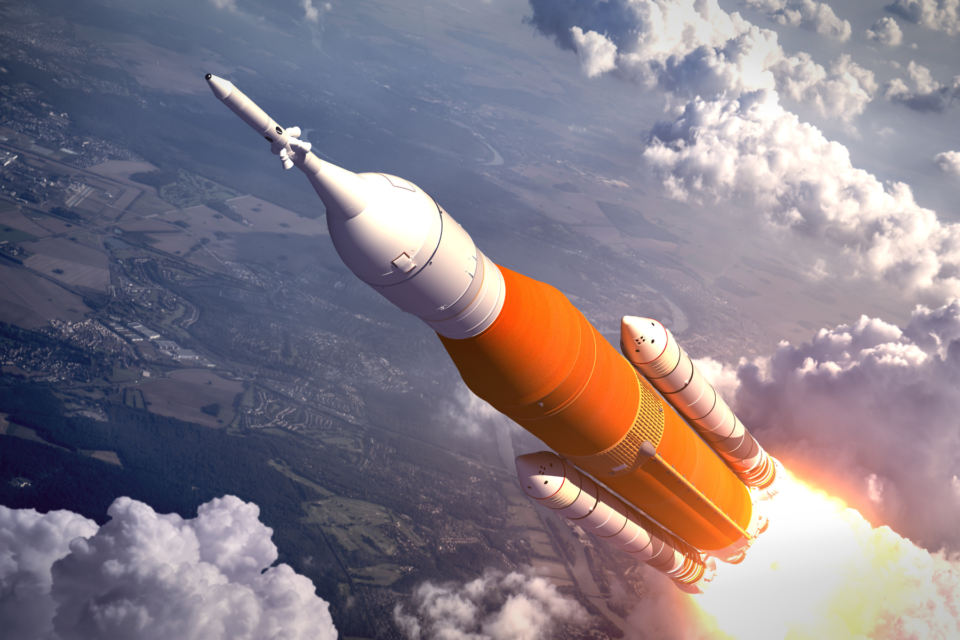How The Space Industry Is Taking Off In 2022

The space economy has seen explosive growth in recent years. Trips are planned for the moon and Mars, more private companies than ever have joined in a new space race, and the public’s imagination has been reignited with the recent release of stunning images from the James Webb Space Telescope. NASA and industry partners such as Boeing, Lockheed Martin, and Jacobs are preparing for a launch of their Artemis 1 mission on the Space Launch System (SLS) rocket, showing the importance of public-private partnerships and bringing us one step closer to the reality of space as an integral part of lives.
To showcase and help us understand the most recent developments in the space industry, the U.S. Chamber will host the Global Aerospace Summit on September 14 and 15, 2022, in Washington, D.C., providing a forum for the industry’s top leaders to discuss the most pressing topics in air and space. Register for the Global Aerospace Summit here.
The Global Aerospace Summit will convene top leaders from commercial aviation, space, and defense for conversations on the impact that the industry will have on the economy, trade, supply chains, cybersecurity, national security, workforce development, and more. Panelists and speakers will explore the challenges and opportunities of a new space economy and share their vision on the innovations and trends that will shape tomorrow.
As the Summit approaches, more businesses and investors should understand what is happening in the space sector. I spoke with the U.S. Chamber’s senior vice president for cyber, space, and national security policy Christopher Roberti on the top questions leaders should know about the space industry in 2022.
During the past few years, the public has become much more interested in space exploration, especially with new trips planned for Mars and the Moon. What are some of the reasons behind this renewed interest?
Several things have captured the imagination of people over the years; going all the way back to the U.S. moon landings, images of planets in the solar system from the Voyager spacecraft, images of distant galaxies from the Hubble telescope and — now — the James Webb telescope and watching in near real-time as the Mars Rover explored the surface of the Red Planet. People can actually imagine worlds beyond ours. This, coupled with tremendous growth in private space companies, who are pushing the boundaries on what we thought was possible – I’m talking about reusable rockets, commercial space stations, hotels in space, and trips to the moon and Mars — all of these activities have renewed public excitement and interest in space.
We will soon see the launch of Artemis I via the Space Launch System, and next year, we will witness the first crew launch of the Boeing Starliner to the International Space Station. People are starting to grasp that space is not some intangible thing, but it is a frontier that we are on the cusp of both exploring and incorporating into global commerce, diplomacy, and human progress.
What are the most pressing challenges facing the commercial space industry?
Of course, there are technical and cost challenges in getting payloads into space economically and at scale. Second, overlapping, complex, and sometimes contradictory regulatory structures inhibit efficient access to space. In the U.S. alone, NASA, the Federal Aviation Administration (FAA), Federal Communications Commission (FCC), Department of Commerce, Department of Defense, and others are involved in regulating access to space in one way or another. That’s not even mentioning various international regulatory schemes and requirements at play. Forces are converging that will require us to figure out a smart and harmonized regulatory framework both domestic and international that allows companies to operate efficiently, effectively, and safely.
How important is the advancement of STEM education to the space sector?
Bolstering STEM education is critical, as there is a tremendous need for qualified people in this highly technical field. We need generations of young people interested in — and committed to — pursuing careers that require a high degree of STEM literacy. This will allow the United States to remain a leader in cutting edge technologies that are critical full development of the space sector and our overall economic and national security.
What are companies in the industry doing to address concerns around space debris
This is an extremely important topic that will be featured in a key panel discussion at the Global Aerospace Summit. While space is vast, the area around the Earth is relatively constricted, with an increasing number of objects flying around, sometimes in close proximity to each other. We need to plan for how to keep these objects out of each other’s way, and to deal with them safely — and sustainably — as they reach the end of their useful lives. Companies like Astroscale are leading in dealing with this problem and will be at our Summit to speak more about their important work.
One area with much interest is national defense in space. How is the global landscape for security changing due to new space technologies?
Space has been a national defense domain for decades, but it wasn’t discussed much. The U.S. has used space, as has its allies and adversaries, in a range of ways, whether that be for remote sensing, imaging, or communications. There’s a growing understanding that equipment in space needs to be hardened and secure — physically and from a cyber perspective. As near-peer adversaries seek to exploit space, the U.S. government, its allied partners, and the private sector must find a way to collaborate closely.
NASA has announced that the International Space Station will be retired after 2030, what’s the plan to replace stations in low earth orbit?
The International Space Station (ISS) has offered the global scientific community a platform for groundbreaking research impossible to replicate on Earth’s surface. Orbiting our planet for over two decades, the ISS is an excellent example of what can be accomplished in space through public-private cooperation and international collaboration. As the retirement of the ISS draws nearer, we look to a future with commercial space stations in low-Earth orbit.
In December 2021, NASA announced the selection of three additional private sector-led initiatives to develop commercial stations in low earth orbit: Orbital Reef (Blue Origin and Sierra Space); Starlab (Nanoracks, Voyager Space, and Lockheed Martin); and Northrop Grumman’s Commercial Space Station. These initiatives join Axiom — which NASA selected in 2020 to build the first commercial destination module for the ISS — as the next generation in orbital platforms. Together, these platforms will contribute to significant scientific and commercial opportunities for the public and private sectors.
Finally, why should people attend the Global Aerospace Summit in mid-September 2022?
First, we have an exceptional group of high-level speakers from government and the aviation and space industries to drive important and relevant discussions. Second, the large audience at the Reagan Building in Washington, DC — upwards of 1,000 people — will offer tremendous opportunities to reconnect with other industry professionals and build new relationships. Finally, we have some really interesting cameo appearances by fascinating people that will capture imaginations and drive enthusiasm for the promise and possibilities of space.


